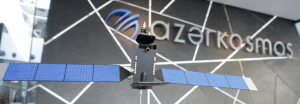Latest News
[Via Satellite 03-13-2015] Intelsat and Azercosmos, the national satellite operator of Azerbaijan, have teamed to deliver a new telecommunications satellite at 45 degrees east. With both companies bringing resources to the mix for the design, manufacture and operational phases of development for the Azerspace 2/Intelsat 38 satellite, the two operators — one a veteran and the other a budding player in the industry — stand to gain vastly different advantages from the arrangement.
According to Intelsat’s Vice President of Corporate Strategy Bruno Fromont, the partnership arose, initially, as one of convenience.
“One of the reasons we engaged in the partnership is that we are in optimal locations; we are very close to each other,” Fromont told Via Satellite. “Azercosmos is a new operator. They have a location at 46 degrees east and we have satellites today at 45 degrees east. Because of this, we thought it would be a good idea to talk to each other and leverage the potential synergies from a spectrum perspective. These days, spectrum is pretty hard to come by.”
In combining efforts and sharing spectrum, Intelsat will gain a customized payload for Direct-to-Home (DTH) applications for the areas that Azercosmos first telecommunications satellite, Azerspace 1/Africasat 1, already covers. These areas include Central and Eastern Europe as well as the Asia Pacific region. The new satellite will also allow Intelsat to provide connectivity for network and government applications in Africa.
As an added bonus, Fromont says the two companies ran into very little overlap. “It’s a partnership; we have done several of them, and some things can go wrong. We can have channel conflicts, such as trying to sell in the same area or go after the same application, which is not the case here,” said Fromont.
While Intelsat stands to gain further coverage, Azercosmos, which launched its first telecommunications satellite in 2013, is looking to expand both its coverage and business strategy through partnering with an established telecommunications giant.
“The current satellite, Azerspace 1, provides Ku-band coverage over most of Central Asia, Central and Eastern Europe, as well as C-band coverage over the same regions in central Asia and Central and Eastern Europe as well as Africa,” Azercosmos Chief Technical Officer Wesley Wong told Via Satellite. “Azerspace 2 will basically augment our existing Ku-band coverage over those same regions as well as expand into Africa in Ku band, as opposed to C band, to meet customer’s demands that we’re seeing there.”
These rising customer demands include both the growing national appetite of the Azerbaijan government as well as the emerging economies of the parts of the world the new satellite will cover, including the Caucuses, Commonwealth of Independent States (CIS) counties and Central and Southwest Asia. As these regions begin to build up their communications infrastructure for DTH broadcasts, Wong says Azerspace 2 will help the company to deliver the more robust services these countries need to continue developing.
“It is an education process — a lot people start with the terrestrial systems, which are a little more commonplace, but then as they mature and develop in their own economies and infrastructure, it becomes increasingly clear that they need a certain added level of capability and robustness in their infrastructure,” said Wong. “They start looking at satellite services, they start looking at it for government services, their militaries, their own national securities start to look at it and when they start to see more and more examples of that, it certainly has that snowball effect and we start to see more requests.”
This addition to the Azercosmos fleet, alongside an Earth Observation (EO) satellite the company recently purchased from Airbus, Azersky, help to cement customer confidence in the company as well as allow the company to offer more capabilities.
And as the telecommunications in these regions continue to grow, Azercosmos is growing its business alongside it. Business strategy is another thing the young, nimble company is hoping to gain from the partnership.
“Azercosmos is one of the newest satellite operators in the industry and this industry is quite competitive with many other more established players,” said Wong. “Partnering with Intelsat gave us the opportunity to work more closely with them to help grow and develop our organization in a more commercially focused way so that we can better execute in all facets of our business and build a sustainable operation going forward.”
Azerspace 2/Intelsat 38 is currently scheduled for a 2017 launch. Together, the companies will be able to align their efforts in bringing capacity to market for new and existing customers. While the two companies may have differing reasons for the partnership, as they begin the process of building and developing their new satellite, they agree that partnerships such as this are less common than they should be in the industry.
“Recently, there have been a lot of satellite operators coming into the [Fixed Satellite Service] FSS market. I think there’s more to gain from working together as opposed to fighting or becoming entrenched in our own positions and boundaries,” said Fromont. “It’s better to work together than to fight. Partnerships are a good thing.”
Get the latest Via Satellite news!
Subscribe Now